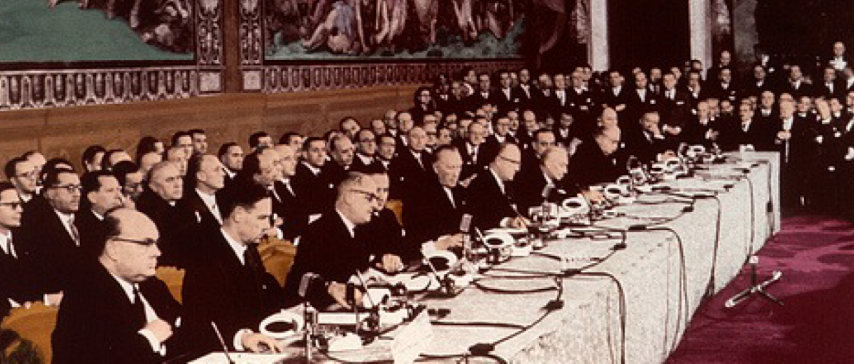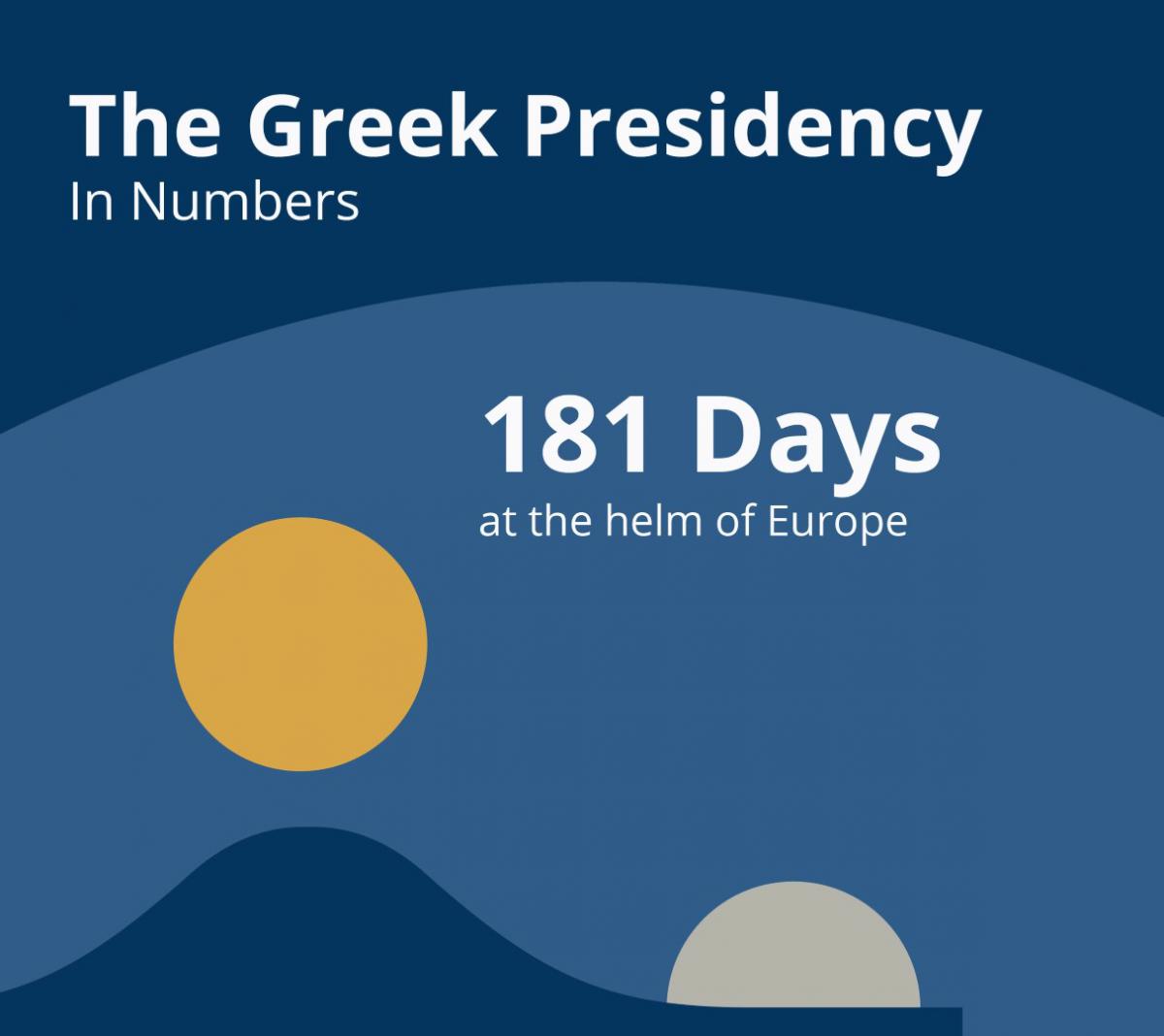| EU Milestones |  |
The historical roots of the European Union lie in the aftermath of the Second World War. European leaders were determined to prevent such killing and destruction from ever happening again. Soon after the war, they decided to foster economic cooperation in order to avert conflicts between neighbours, on the rationale that countries trading with one another become economically interdependent and thus likely to avoid conflict.
Indeed, the first milestone of European integration was put forward on 9 May 1950 by the French foreign minister Robert Schuman. Speaking in Paris, he proposed a new plan, known as the “Schuman plan”, for deeper political cooperation throughout Europe, which would make war between Europe’s nations not only unthinkable, but materially impossible and thus secure lasting peace.
Video: "Fathers of Europe" (produced in 2010)
Source: EuroparlTV
Learn more about the EU’s exciting history
Through eras of turbulence and years of tranquility, in good times and in bad times, the EU remains a unique and evolving economic and political partnership between European countries, an organisation whose appeal has not withered, as successive enlargements have demonstrated. Intrinsically linked to consistent values such as stability, security, economic growth and peace, sixty-three years on and given the current state of affairs of the economic crisis, these values remain timely. Today, more than ever, we need to reflect and reinvent our common European values, which are a vital component of the European structure.
The values of democracy, freedom, respect for human rights, mutual understanding and solidarity are values currently under attack from ideologies sharing roots with those that once bloodied Europe. Today as never before, collective action and unshakeable faith in the European vision guide us towards meeting all the social, financial, and environmental challenges we face.
The benefits of the Union for Member States are countless, outweighing all possible drawbacks and rendering an EU exit practically unthinkable. By pooling their strengths, Member States can do better for their citizens. We will only overcome current challenges together. United in our “ever closer” Union.
There follows a brief summary of key milestones in the development of the EU.
The Coal and Steel Community
Based on the “Schuman plan”, six European countries began cooperation and signed a treaty to run their heavy industries – coal and steel – under a common management. Its purpose was to create interdependence in coal and steel, industries critical to war, but also important for trade.
The “Treaty of Paris” was signed on 18 April 1951 and established the Coal and Steel Community (ECSC) between six founding Member States: Belgium, France, Germany, Italy, Luxembourg and the Netherlands.
The ECSC proved a success, and the initially small European Coal and Steel Community evolved over time into the European Union of 28 Member States and nearly 500 million people. A number of subsequent treaties marked its evolution into the European Union we know today.
The European Economic Community
On 25 March 1957 in Rome, the six founding countries signed two new treaties in order to expand their cooperation in other fields: The first established the European Economic Community (EEC) and the second the European Atomic Energy Community, better known as Euratom.
The two treaties led to the creation of a customs union, a common market based on the principle of free movement of capital, goods, services and people, and a framework for enhanced research cooperation on nuclear energy.
In 1967, upon initiative of the Dutch government, the six Member States agreed to merge the institutions of the three European Communities – ECSC, EEC and EURATOM – into a single framework for the “European Community”, with a single European Commission and a single Council.
The Single European Act
Signed on 17 February 1986 in Luxembourg, the Single European Act revised the Treaties of Rome in order to add new momentum to European integration and to complete the internal market. It amended the rules governing the operation of the European institutions and expands Community powers, in the fields of research and development, the environment and common foreign policy.
The Treaty of Maastrich
Signed on 7 February 1992, The Treaty on European Union, also known as the Treaty of Maastricht marks a new era in European integration, since it expands European cooperation beyond the economic field, opening the way to political integration.
It creates a European Union consisting of three pillars: the European Communities, Common Foreign and Security Policy (CFSP), and police and judicial cooperation in criminal matters (JHA).
It also introduces the concept of European citizenship, reinforces the powers of the European Parliament and launches the economic and monetary union (EMU). Under this treaty, the name of “European Union” officially replaces “European Community”.
Thus, what began as a purely economic union evolved into an organisation spanning policy areas, from development aid to the environment, and the name change from EEC to European Union (EU) reflects this.
The Single European Market
Since its conception, Europe’s ambition was to create a fully integrated single market. In a series of reforms that culminated in 1993, EU Member States managed to abolish hundreds of technical, legal and bureaucratic barriers that stifled free trade and free movement across Europe. The vision of a Single European Market thus became a reality.
The cornerstones of the single market are the so-called “four freedoms” – the free movement of people, goods, services and capital. It is all about bringing down barriers and simplifying existing rules to enable everyone in the EU to make the most of the opportunities offered to them.
Throughout the years, the single market has helped to create more jobs and increase overall prosperity in the EU. It has provided European businesses with unfettered access to a market of 500 million individuals and has offered greater variety at better prices to consumers across Europe.
The Schengen Agreement
On 26 March 1995, the Schengen Agreement takes effect in seven EU Member States (Belgium, France, Germany, Luxembourg, the Netherlands, Spain and Portugal). The signatory states to the agreement abolished all internal borders in lieu of a single external border. Within this area, known as the “Schengen area”, common rules and procedures are applied with regard to visas for short stays, asylum requests and border controls.
Simultaneously, to guarantee security within the Schengen area, cooperation and coordination between police services and judicial authorities have been stepped up. Schengen cooperation was incorporated into the European Union legal framework by the Treaty of Amsterdam of 1997.
The Treaty of Amsterdam
Signed on 17 June 1997, the Treaty of Amsterdam aimed to reform EU institutions in preparation for the arrival of new member states. Its general purpose was to give Europe a stronger voice in the world and to concentrate more resources on employment and the rights of citizens.
Among the main changes it introduced were the amendment, renumbering and consolidation of EU and EEC treaties, along with the increased use of the co-decision voting procedure, enabling more transparent decision-making.
The Nice Treaty
Signed on 26 February 2001, and effective as of 1 February 2003, the Treaty of Nice opened the way to the institutional reform necessary for the enlargement of the EU with the accession of countries from eastern and southern Europe.
The main changes it introduced relate to limiting the size and composition of the Commission, extending qualified majority voting, a new weighting of votes within the Council and making the strengthened cooperation arrangements more flexible.
The Lisbon Treaty
The Treaty of Lisbon was signed on 13 December 2007. It is designed to make the EU more democratic, efficient and transparent so as to successfully tackle global challenges of the 21st century, such as climate change, security and sustainable development. It reinforces democracy in the EU and its capacity to promote the interests of its citizens on a day-to-day basis.
It does so by reinforcing the powers of the European Parliament, enhancing the role of national parliaments, and providing a right for citizens to directly request proposals from the Commission. It simplifies and strengthens decision-making by streamlining procedures and voting rules, and by creating a permanent President of the European Council. It strengthens the EU’s foreign policy through the creation of a common foreign service and a High Representative to speak and act on behalf of the EU. Last but not least, it incorporates the Charter of Fundamental Rights into EU law.
Enlargement
The EU is a unique economic and political partnership between 28 European countries that together cover much of the continent. In 1951, six countries founded the European Coal and Steel Community. Sixty-three years later, a further 22 countries have joined the EU, including a historic expansion in 2004 marking the re-unification of Europe after decades of division
1951: Belgium, Germany, France, Italy Luxembourg and the Netherlands
1973: Denmark, Ireland and the UK
1981: Greece
1986: Portugal and Spain
1995: Finland, Sweden and Austria
2004: Czech Republic, Cyprus, Estonia, Latvia, Lithuania, Hungary, Malta, Poland, Slovenia and Slovakia.
2007: Bulgaria and Romania
2013: Croatia
Iceland, Turkey, Montenegro, Serbia and the Former Yugoslav Republic of Macedonia have obtained candidate status. Three more countries – Albania, Bosnia and Herzegovina and Kosovo (under UN Security Council Resolution 1244) – are potential candidates.
Before a candidate country can join the EU, it must implement existing EU legislation and meet standards for democracy, justice and human rights. The candidate country must also have a well-functioning market economy. The requirements are high and enlargement negotiations may therefore extend over several years.
The Euro
The introduction of the euro in 1999 was a major step in European integration as well as one of its major successes: around 330 million EU citizens now use it as their currency and enjoy its benefits, which will spread even more widely as other EU countries adopt the single currency.
Since 1 January 2002, the euro has been circulating in physical form, as banknotes and coins. They all circulate free across the Eurozone formed by the EU Member States that have adopted the euro as their common currency. Currently the Eurozone consists of 17 Member States.
1999: Austria, Belgium, Finland, France, Germany, Ireland, Italy, Luxembourg, the Netherlands, Portugal and Spain
2001: Greece
2002: Introduction of euro banknotes and coins
2007: Slovenia
2008: Cyprus, Malta
2009: Slovakia
2011: Estonia
On 1.1.2014 Latvia will become the 18th Member State of the Eurozone.
To adopt the euro, Member States must meet conditions concerning interest rates, budget deficits, inflation, sovereign debt and currency stability. The circulation of the euro is managed by the European Central Bank. Its main purpose is to ensure price stability within the «Eurozone” by conducting the appropriate monetary policy.
EU Economic Governance and Financial Assistance
The EU and its Member States have agreed on a series of important issues aiming to promote economic and budgetary coordination for the EU as a whole and for the Eurozone in particular.
Moreover, in order to respond to the unprecedented economic and financial crisis, the EU and euro area Member States have taken intense and sustained action setting up financial assistance mechanisms capable of supporting Member States in difficulty, and thus preserving the financial stability of both the EU and the Eurozone.






